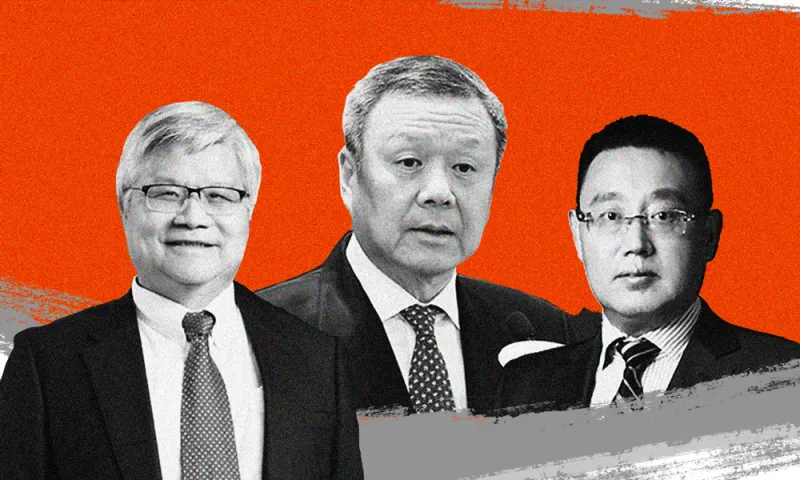If the summer of 2020 had Asia’s top executives fretting over a second surge in coronavirus cases, in 2021 their thoughts are turning to the post-pandemic world on the horizon.
XiaoHai Hou — the top scoring CEO in the consumer and staples category of Institutional Investor’s 2021 All-Asia Executive Team — is wondering how to grasp the challenges and opportunities posed by an explosion in demand for craft beer in China. In the U.S., this so-called “premiumization” now means the transformation of beer beyond craft brands into a market where it is competing with hard seltzer and other flavored malt beverages. But China is earlier in that curve, experiencing huge growth in the craft beer sector, with wholesalers and online retailers shifting to more premium products in order to survive.
In recent years, Hou’s company China Resources Beer (Holdings) Co. has led beer sales across the Chinese market, with a total volume share of 25 percent in 2019. But overall volumes of beer consumption are declining. Analysts expect a record 2 percent decline in volume by 2024, or a fall of 42.2 billion liters.
CR Beer is banking on the size of its market share and innovations in marketing to maintain its lead. When Heineken took a 40 percent stake in the company in 2018 for $3.1 billion, it opened the way for international beers Heineken, Amstel, Sol, and Tiger to enter the Chinese market. Hou said the combination of these big international names with four Chinese brands — superX, Marrs Green, Craftsmanship, and Opera Mask — gives CR Beer the edge over competitors that offer just local or just international options.
In the telecommunications sector, Xiaochu Wang from China Unicom is celebrating 11 consecutive years as the top-rated chief executive in II’s poll, meaning he has an unbroken run at the top spot since the rankings launched. His firm China Unicom is the third-biggest Chinese telecoms provider alongside fellow state-run companies China Telecom and China Mobile. It saw high demand for digital products during the pandemic, including the use of 5G and thermal imaging to screen temperature and make remote diagnosis, tools to facilitate remote office working and remote schooling, andcloud conferencing and pandemic monitoring using artificial intelligence. “[We] made all-out efforts to help combat the pandemic,” Wang said. The efforts paid off: in March, China Unicom reported a 10 percent increase in earnings for the full year.
Artificial intelligence and 5G are also driving demand for semiconductors, according to C.C. Wei, CEO at Taiwan Semiconductor Manufacturing Co. and the highest scoring chief executive in the technology and semiconductor category.
“Keeping up with changing and increasing customer demand has been a challenge this year,” he said. “It might be an understatement to say that the peaks and troughs of semiconductor demand were more turbulent than we would normally expect.”
The pandemic created an explosion in demand for the world’s biggest contract chipmaker, but it also brought about some difficult decisions, as the pandemic caused a shortage of semiconductors used in cars and computers. When demand for new cars dropped off a cliff at the start of 2020, semiconductor providers naturally shifted their supply away from car manufacturers — only to find that they could not keep up when the demand from the car sector bounced back later in 2020. Wei took the unprecedented decision to switch supply away from other sectors and back to the car industry, increasing 2021 output for microprocessor control units, one of the key components in automotive semiconductor products, by 60 percent compared to 2020.
Wei said the company is now planning to up its capacity to meet continued high demand for its products, while trying to stay ahead of its customers’ decisions through constant dialogue.
“It’s a case of being open to learning every day,” he said. “Learning which comes through conversations with our employees, our customers, and our partners.”
XiaoHai Hou, China Resources Beer (Holdings) Co.
What is the greatest challenge for your sector this year?
The world continues to follow the path of recovery after a severe pandemic. A lot of opportunities have also emerged in the course of the recovery. In such an environment, how to grasp the opportunities, in particular to continuously promote premiumization, is one of the greatest challenges in the China beer industry.Have there been any unexpected opportunities for your business in the last year?
At the start of the pandemic, at the beginning of the year 2020, the company performed detailed analysis and judgement to conclude that the pandemic would bring opportunities for our development. We set up a corresponding strategy for the premiumization target and brand development in China: no change in target, strategy and investment as well as more accurate investment. It also affirmed our decision to react swiftly in the immediate aftermath of the pandemic. Eventually, the company secured good growth and resources to support the premiumization development.How is your company innovating?
Most of the beer players in the China beer market concentrate on the development of either their Chinese or international premium beer segment. In contrast, our company uses a 4+4 dual brand products portfolio premiumization strategy so as to satisfy the customers’ demand for quality, individualization and differentiation. Among the 4+4 products portfolio, four core Chinese brands’ premiumization products include superX, Marrs Green, the Craftsmanship, and Opera Mask, whereas four core International brands’ premiumization products include Heineken, Amstel, Sol, Tiger, etc. Other than the innovation on product portfolio development, the company is also being creative about the promotion of individual products. The product design and brand promotion of Opera Mask and the Craftsmanship are in close connection with Chinese culture. SuperX and Marrsgreen are addressing young consumers, which are a group with huge potential for high-end consumption. Among these, superX further expresses the brave spirit of those customers aged between 18 and 25 who live life with no fear, ensuring a feeling of freshness for consumers.Che Chia (C.C.) Wei, Taiwan Semiconductor Manufacturing Co.
What is the greatest challenge for your sector this year?
Keeping up with changing and increasing customer demand has been a challenge this year. In addition to industry megatrends such as 5G and AI continuing to drive semiconductor demand, the global pandemic disrupted the forecasts for customers across all sectors. It might be an understatement to say that the peaks and troughs of semiconductor demand were more turbulent than we would normally expect.What was the toughest business decision you made in the last year?
TSMC is everyone’s foundry. We always try to support all our customers equally, in every sector, of every size, and we take our commitment seriously. So having to take unprecedented actions, including the reallocation of capacity from customers from other industries who are experiencing stressfully high demand due to the acceleration of digital transformation, to support the automotive sector was a tough decision, but one which we felt was necessary to support our customers’ urgent need.With a fixed short-term capacity, we managed to successfully increase 2021 output for microprocessor control units, one of the key components in automotive semiconductor products, by 60 percent over the 2020 level, representing a 30 percent increase over the 2019 pre-pandemic level in this critical product category.







